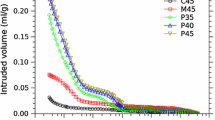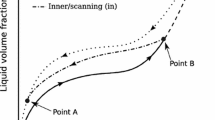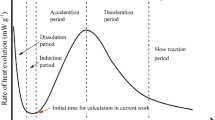Abstract
Finding a simple analytical model to represent dynamic water-vapor sorption (DWVS) in cement-based porous materials (CBPMs) is a challenging task because the physical–chemical interactions between water molecules and materials are quite complex. This paper presents a two-parameter stretched exponential function called the fractional kinetic (FK) model to represent the DWVS process in CBPMs. The FK model has a flexible and robust formula that is determined by two key parameters: the kinetic order n and the time index \(\alpha\). With conditioned n and \(\alpha\) values, the FK model reduces to the classic exponential model and first- and second-order sorption models. The DWVS data of hardened blended cement-paste samples with different shapes was used to test the applicability of the FK model. The FK model can represent the early sorption data that is generally described by Fick’s diffusion law and the late sorption data that matches the classic exponential model. Sorption of water vapor in CBPMs is a complex time-dependent process that is associated with the interactions between water molecules and the contact surfaces, as well as the microstructures of the cement-based materials.








Similar content being viewed by others
Notes
Here, we use Q to represent the quantity (either mass, volume, number, or moles) by sorption and M to specifically represent the sorption mass.
References
Maruyama I, Nishioka Y, Igarashi G, Matsui K (2014) Microstructural and bulk property changes in hardened cement paste during the first drying process. Cem Concr Res 58:20–34
Maruyama I, Sasano H, Nishioka Y, Igarashi G (2014) Strength and Young’s modulus change in concrete due to long-term drying and heating up to \(90\,^\circ \text{ C }\). Cem Concr Res 66:48–63
Maruyama I, Igarashi G, Nishioka Y (2015) Bimodal behavior of C–S–H interpreted from short-term length change and water vapor sorption isotherms of hardened cement paste. Cem Concr Res 73:158–168
Saeidpour M, Wadso L (2015) Moisture equilibrium of cement based materials containing slag or silica fume and exposed to repeated sorption cycles. Cem Concr Res 69:88–95
Zeng Q, Zhang DD, Sun H, Li K (2014) Characterizing pore structure of cement blend pastes using water vapor sorption analysis. Mater Charact 95:72–84
Wu M, Johannesson B, Geiker M (2014) Application of water vapor sorption measurements for porosity characterization of hardened cement pastes. Constr Build Mater 66:621–633
Wu M, Johannesson B, Geiker M (2014) A study of the water vapor sorption isotherms of hardened cement pastes: possible pore structure changes at low relative humidity and the impact of temperature on isotherms. Cem Concr Res 56:97–105
Snoeck D, Velasco LF, Mignon A, Van Vlierberghe S, Dubruel P, Lodewyckx P, De Belie N (2014) The influence of different drying techniques on the water sorption properties of cement-based materials. Cem Concr Res 64:54–62
Baroghel-Bouny V (2007) Water vapour sorption experiments on hardened cementitious materials: part I: essential tool for analysis of hygral behaviour and its relation to pore structure. Cem Concr Res 37:414–37
Gustavsson C, Piculell L (2016) Isotherms and kinetics of water vapor sorption/desorption for surface films of polyionsurfactant ion complex salts. J Phys Chem B 120(27):6778–6790
Dubin E, Wadso L, Plank L (2011) A sorption balance study of water vapour sorption on anhydrous cement minerals and cement constituents. Cem Concr Res 41:1196–1204
Sheokand S, Modi SR, Bansal AK (2016) Quantification of low levels of amorphous content in crystalline celecoxib using dynamic vapor sorption (DVS). Eur J Pharm Biopharm 102:77–86
Zeng Q, Wang Y, Li K (2014) Uniform model for moisture transport in porous materials and its application to concrete at selected Chinese regions. J Mater Civ Eng 26:05014001
Poyet S, Charles S, Honoré N, L’hostis V (2011) Assessment of the unsaturated water transport properties of an old concrete: determination of the pore-interaction factor. Cem Concr Res 41:1015–1023
Apeagyei AK, Grenfell JR, Airey GD (2015) Application of Fickian and non-Fickian diffusion models to study moisture diffusion in asphalt mastics. Mater Struct 48(5):1461–1474
Saeidpour M, Wadso L (2015) Evidence for anomalous water vapor sorption kinetics in cement based materials. Cem Concr Res 70:60–66
Baroghel-Bouny V, Mainguy M, Lassabatere T, Coussy O (1999) Characterization and identification of equilibrium and transfer moisture properties for ordinary and high-performance cementitious materials. Cem Concr Res 29:1225–1238
Mainguy M, Coussy O, Baroghel-Bouny V (2001) Role of air pressure in drying of weakly permeable materials. J Eng Mech 127(6):582–592
Litavcova E, Korjenic A, Korjenic S, Pavlus M, Sarhadov I, Seman J, Bednar T (2014) Diffusion of moisture into building materials: a model for moisture transport. Energy Build 68:558–561
Anderberg A, Wadso L (2008) Method for simultaneous determination of sorption isotherms and diffusivity of cement-based materials. Cem Concr Res 38:89–94
Willems HH, Van Der Velden KB (1984) A gravimetric study of water vapour sorption on hydrated cement pastes. Thermochim Acta 82:211–220
Hall C (2007) Anomalous diffusion in unsaturated flow: fact or fiction? Cem Concr Res 37:378–385
Hansen CM (2010) The significance of the surface condition in solutions to the diffusion equation: explaining “anomalous” sigmoidal, Case II, and Super Case II absorption behavior. Eur Polym J 46:651–662
Petropoulos JH, Sanopoulou M, Papadokostaki KG (2011) Physically insightful modeling of non-Fickian kinetic regimes encountered in fundamental studies of isothermal sorption of swelling agents in polymeric media. Eur Polym J 47:2053–2062
Su NH (2009) Equations of anomalous absorption onto swelling porous media. Mater Lett 63:2483–2485
Kuntz M, Lavallee P (2001) 4) Experimental evidence and theoretical analysis of anomalous diffusion during water infiltration in porous building materials. J Phys D: Appl Phys 34:2547. doi:10.1088/0022-3727/34/16/322
Quenard D, Sallee H (1992) Water vapour adsorption and transfer in cement-based materials: a network simulation. Mater Struct 25(9):515–522
Ishida T, Maekawa K, Kishi T (2007) Enhanced modeling of moisture equilibrium and transport in cementitious materials under arbitrary temperature and relative humidity history. Cem Concr Res 37:565–578
Kopelman R (1988) Fractal reaction kinetics. Science 241:1620–1626
Jurlewicz A, Weron K (1999) A general probabilistic approach to the universal relaxation response of complex systems. Cell Mol Biol Lett 4(1):55–86
Niven RK (2006) \(q\)-Exponential structure of arbitrary-order reaction kinetics. Chem Eng Sci 61:3785–3790
Tsallis C (2009) Introduction to nonextensive statistical mechanics: approaching a complex world. Springer, New York
Brouers F, Sotolongo-Costa O (2006) Generalized fractal kinetics in complex systems (application to biophysics and biotechnology). Phys A 368:165–175
Haerifar M, Azizian S (2012) Fractal-like adsorption kinetics at the solid/solution interface. J Phys Chem C 116:13111–13119
Li Q, Xu S, Zeng Q (2016) A fractional kinetic model for drying of cement-based porous materials. Dry Technol 34(10):1231–1242
Zeng Q, Zheng D, Chen B (2016). Drying of cement-based porous materials: a fractional kinetic approach. “Moisture in materials and structures”. In: Proceedings of the international RILEM conference on materials, systems and structures in civil engineering. Technical University of Denmark, Lyngby, 22–24 Aug 2016, pp 41–50
Hou D, Zhao T, Ma H, Li Z (2015) Reactive molecular simulation on water confined in the nanopores of the calcium silicate hydrate gel: structure, reactivity, and mechanical properties. J Phys Chem C 119:1346–1358
Hou D, Ma H, Zhu Y, Li Z (2014) Calcium silicate hydrate from dry to saturated state: structure, dynamics and mechanical properties. Acta Mater 67:81–94
Hou D, Li L (2014) Molecular dynamics study of water and ions transport in nano-pore of layered structure: a case study of tobermorite. Microporous Mesoporous Mater 195:9–20
Hou D, Zhao T, Jin Z, Li Z (2015) Structure, reactivity and mechanical properties of water ultra-confined in the ordered crystal: a case study of jennite. Microporous Mesoporous Mater 204:106–114
Zeng Q, Li K, Fen-Chong T, Dangla P (2012) Pore structure characterization of cement pastes blended with high-volume fly-ash. Cem Concr Res 42:194–204
Zeng Q, Li K (2015) Reaction and microstructure of cementfly-ash system. Mater Struct 48(6):1703–1716
Zeng Q, Li K, Fen-Chong T, Dangla P (2016) Pore structure of cement pastes through NAD and MIP analysis. Adv Cem Res 28(1):23–32
Zeng Q, Luo M, Pang X, Li L, Li K (2013) Surface fractal dimension: an indicator to characterize the microstructure of cement-based porous materials. Appl Surf Sci 282:302–307
Zeng Q, Li K, Fen-Chong T, Dangla P (2010) Surface fractal analysis of pore structure of high-volume fly-ash cement pastes. Appl Surf Sci 257:762–768
Zeng Q, Li K, Fen-Chong T, Dangla P (2012) Analysis of pore structure, contact angle and pore entrapment of blended cement pastes from mercury porosimetry data. Cem Concr Compos 34(9):1053–1060
Li K, Zeng Q, Luo M, Pang X (2014) Effect of self-desiccation on the pore structure of paste and mortar incorporating 70% GGBS. Constr Build Mater 51:329–337
Fischer N, Haerdtl R, McDonald PJ (2015) Observation of the redistribution of nanoscale water filled porosity in cement based materials during wetting. Cem Concr Res 68:148–155
Rodin V, Valori A, McDonald PJ (2011) A 1H double-quantum-filtered NMR study of water in cement pastes. New J Phys 13:035017. doi:10.1088/1367-2630/13/3/035017
Borland L, Pennini F, Plastino AR, Plastino A (1999) The nonlinear Fokker–Planck equation with state-dependent diffusion-A nonextensive maximum entropy approach. Eur Phys J B 12:285–297
Burr IW (1942) Cumulative frequency functions. Ann Math Stat 13:215–232
Plazinski W (2013) Binding of heavy metals by algal biosorbents. Theoretical models of kinetics, equilibria and thermodynamics. Adv Colloid Interface Sci 197–198:58–67
Bashiri H (2011) Desorption kinetics at the solid/solution interface: a theoretical description by statistical rate theory for close-to-equilibrium systems. J Phys Chem C 115:5732–5739
Weibull W (1951) A statistical distribution function of wide applicability. J Appl Mech 18:293–297
Lopes EC, dos Anjos FS, Vieira EF, Cestari AR (2003) An alternative Avrami equation to evaluate kinetic parameters of the interaction of Hg (II) with thin chitosan membranes. J Colloid Interface Sci 263(2):542–547
Li K, Pang X (2014) Sorption of radionuclides by cement-based barrier materials. Cem Concr Res 65:52–57
Ahmad-Qasem MH, Barrajon-Catalan E, Micol V, Cárcel JA, Garcia-Perez JV (2013) Influence of air temperature on drying kinetics and antioxidant potential of olive pomace. J Food Eng 119:516–524
Delgado J, Ramos NMM, De Freitas VP (2006) Can moisture buffer performance be estimated from sorption kinetics? J Build Phys 29:281–299
Johannesson B (2002) Prestudy on diffusion and transient condensation of water vapor in cement mortar. Cem Concr Res 32:955–962
Tada S, Watanabe K (2005) Dynamic determination of sorption isotherm of cement based materials. Cem Concr Res 35:2271–2277
McDonald PJ, Rodin V, Valori A (2010) Characterisation of intra- and inter-C–S–H gel pore water in white cement based on an analysis of NMR signal amplitudes as a function of water content. Cem Concr Res 40:1656–1663
Hall C, Hoff WD, Taylor SC, Wilson MA, Yoon BG, Reinhardt HW, Sosoro M, Meredith P, Donald AM (1995) Water anomaly in capillary liquid absorption by cement-based materials. J Mater Sci Lett 14:1178–1181
Griffin IM, Hall C, Hamilton A (2014) Unusual water transport properties of some traditional Scottish shale bricks. Mater Struct 47:1761–1771
Ranaivomanana H, Verdier J, Sellier A, Bourbon X (2013) Prediction of relative permeabilities and water vapor diffusion reduction factor for cement-based materials. Cem Concr Res 48:53–63
Jennings HM (2008) Refinements to colloid model of CSH in cement: CM-II. Cem Concr Res 38:275–289
Vandamme M, Ulm FJ (2009) Nanogranular origin of concrete creep. Proc Natl Acad Sci USA 106:10552–10557
Plociniczak L (2015) Analytical studies of a time-fractional porous medium equation. Derivation, approximation and applications. Commun Nonlinear Sci Numer Simul 24:169–183
Sun H, Meerschaert MM, Zhang Y, Zhu J, Chen W (2013) A fractal Richards’ equation to capture the non-Boltzmann scaling of water transport in unsaturated media. Adv Water Resour 52:292–295
Acknowledgements
We thank M. Saeidpour for kindly providing the sorption data of the cement-based materials.
Funding
This study was funded by the National Natural Science Foundation of China (Grant Number 51408536) and Open Fund of Jiangsu Key Laboratory of Construction Materials.
Author information
Authors and Affiliations
Corresponding author
Ethics declarations
Conflict of interest
The authors declare that they have no conflict of interest.
Rights and permissions
About this article
Cite this article
Zeng, Q., Xu, S. A two-parameter stretched exponential function for dynamic water vapor sorption of cement-based porous materials. Mater Struct 50, 128 (2017). https://doi.org/10.1617/s11527-017-0997-7
Received:
Accepted:
Published:
DOI: https://doi.org/10.1617/s11527-017-0997-7




